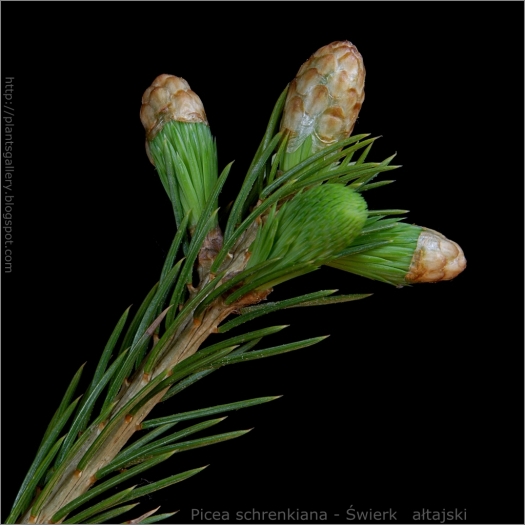Schrenk’s Spruce
(Picea schrenkiana)
Schrenk’s Spruce (Picea schrenkiana)
/
/

Babij
CC BY-SA 2.0
Image By:
Babij
Recorded By:
Copyright:
CC BY-SA 2.0
Copyright Notice:
Photo by: Babij | License Type: CC BY-SA 2.0 | License URL: https://creativecommons.org/licenses/by-sa/2.0/ | Uploader: Babij | Publisher: Flickr |


























Estimated Native Range
Summary
Picea schrenkiana, commonly known as Schrenk’s Spruce or Asian Spruce, is an evergreen tree native to the mountainous regions of Central Asia, specifically the Tien Shan and Altai Mountains, and Western China. It thrives in subalpine zones and montane forests, where it forms a significant part of the coniferous woodland ecology. Schrenk’s Spruce can grow to a height of 40–50 meters (130–160 ft) with a trunk diameter of up to 1–2 meters (3.3–6.6 ft). Its narrow conical crown, level branches, and sometimes pendulous branchlets give it a distinctive, elegant appearance. The tree is also notable for its smooth, gray bark and cylindrical cones that are 5–10 cm long.
Schrenk’s Spruce is valued for its tall and stately form, making it a popular choice for large gardens, parks, and as a specimen tree in urban landscapes. Its ability to adapt to a range of soil types, provided they are well-drained, and its tolerance for both full sun and partial shade make it a versatile addition to cultivation. It requires medium amounts of water and benefits from a cool, moist climate. While it is generally low-maintenance, it can be susceptible to pests such as aphids and diseases like needle cast. Gardeners should be aware of its potential to grow very large, which may not be suitable for smaller spaces.CC BY-SA 4.0
Schrenk’s Spruce is valued for its tall and stately form, making it a popular choice for large gardens, parks, and as a specimen tree in urban landscapes. Its ability to adapt to a range of soil types, provided they are well-drained, and its tolerance for both full sun and partial shade make it a versatile addition to cultivation. It requires medium amounts of water and benefits from a cool, moist climate. While it is generally low-maintenance, it can be susceptible to pests such as aphids and diseases like needle cast. Gardeners should be aware of its potential to grow very large, which may not be suitable for smaller spaces.CC BY-SA 4.0
Plant Description
- Plant Type: Tree
- Height: 30-75 feet
- Width: 20-45 feet
- Growth Rate: Moderate
- Flower Color: N/A
- Flowering Season: Non-Flowering
- Leaf Retention: Evergreen
Growth Requirements
- Sun: Full Sun, Part Shade
- Water: Medium
- Drainage: Medium
Common Uses
Bird Garden, Deer Resistant, Low Maintenance, Rabbit Resistant, Rock Garden
Natural Habitat
Native to the mountainous regions of Central Asia and montane forests
Other Names
Common Names: Schrenk’s Spruce , Schrenk Spruce , Schrenk-Fichte , Tienschan-Fichte , Épicéa De Schrenk , Tiensani Hosszútus Luc , Abete Di Schrenk , Ель Шренка (El’ Shrenka) , Ель Тяньшаньская (El’ Tyan’shan’skaya) , 学岭松 (Xue Ling Song)
Scientific Names: Picea schrenkiana , Pinus abies f. schrenkiana
GBIF Accepted Name: Picea schrenkiana Fisch. & C.A.Mey.